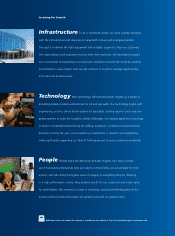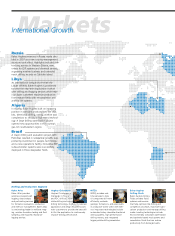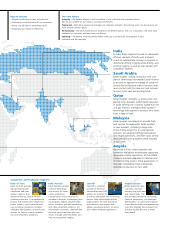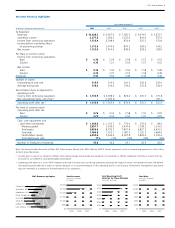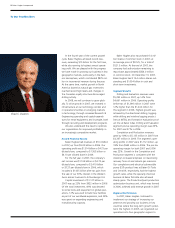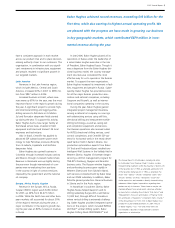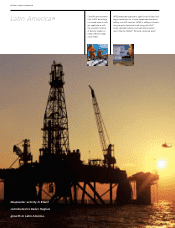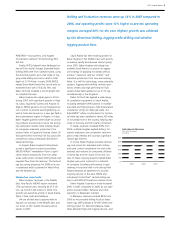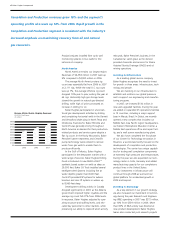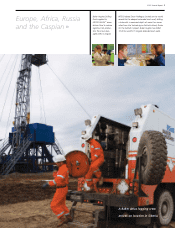Baker Hughes 2007 Annual Report Download - page 10
Download and view the complete annual report
Please find page 10 of the 2007 Baker Hughes annual report below. You can navigate through the pages in the report by either clicking on the pages listed below, or by using the keyword search tool below to find specific information within the annual report.
Completion and Production revenues grew 18% and the segment’s
operating profits also were up 18% from 2006. Rapid growth in the
Completion and Production segment is consistent with the industry’s
increased emphasis on maximizing recovery from oil and natural
gas reservoirs.
Europe, Africa, Russia, Caspian Revenues
2005–2007, by Quarter
(In millions)
$900
$800
$700
$600
$500
$400
$300
$200
$100
$0
2005 2006 2007
6 Baker Hughes Incorporated
ProductionQuest installed fiber optic well
monitoring systems in two wells for the
national oil company.
North America
North America remains our largest region.
Revenues of $4,358 million in 2007 were up
9% compared to $4,000 million in 2006.
The average North America rotary rig
count was essentially flat from 2006 to 2007
at 2,111 rigs. While the total U.S. rig count
was up 7%, the average offshore rig count
dropped 19% year to year, ending the year at
64 rigs. Historically high gas storage levels
slowed the growth in natural gas-directed
drilling, while high oil prices prompted an
increase in drilling for oil.
Baker Hughes participated in unconven-
tional gas development activities by drilling
and completing horizontal wells in the Barnett
and Woodford shale plays in North Texas and
Oklahoma. Business for Baker Petrolite and
Centrilift was generally strong throughout
North America as demand for their production-
related products and services grew despite a
flat rig count. In the Rocky Mountains, Baker
Petrolite foamer treatments and Centrilift
pump technology were utilized to remove
water from gas wells to enable them to
produce efficiently.
In the Gulf of Mexico, Baker Hughes
participated in the deepwater market with a
wide range of services. Baker Hughes Drilling
Fluids introduced its new RHEO-LOGIC™
synthetic based system on wells as deep as
29,500 feet. Baker Oil Tools installed several
Intelligent Well Systems including five at
water depths greater than 8,000 feet.
Centrilift provided ESP systems for subsea
boosters and riser lift systems in waters up
to 8,960 feet deep.
Development drilling activity in Canada
dropped significantly in 2007, as the Alberta
government imposed higher royalties and the
average rig count fell 27% from 2006 levels.
In response, Baker Hughes adjusted its oper-
ating structure and staffing levels, and relo-
cated key personnel to other markets, while
preserving our ability to respond when activity
rebounds. Baker Petrolite’s business in the
Canadian tar sands grew as the division
provided chemicals and services for Steam
Assisted Gravity Drainage (SAGD) and oil
mining operations.
Investing in Infrastructure
As a leading global service company,
Baker Hughes recognizes the need to invest
for growth in three areas: infrastructure, tech-
nology and people.
We are investing in our infrastructure to
establish and reinforce our global presence
and to support our engineering and manufac-
turing programs.
In 2007, we invested $130 million in
new and upgraded facilities. During the year,
we added or expanded 25 operations facilities
in 12 countries, including a major support
base in Macaé, Brazil. In Dubai, we recently
opened a new complex that includes our
Middle East, Asia Pacific region headquarters,
our Eastern Hemisphere Education Center, a
Middle East operations office and repair facil-
ity, and a well screen manufacturing plant.
We also have completed the first phase
of our Center for Technology Innovation in
Houston, a world-class facility focused on the
development of completion and production
technologies. The center has unique capabili-
ties for testing well completion components
at extremely high pressures and temperatures.
During the year, we also expanded our tech-
nology center in Celle, Germany and added
manufacturing capacity for our completions
product lines in the United States.
Our investment in infrastructure will
continue through 2008 as we build our
global platform for accelerated growth in
2009 and beyond.
Investing in Technology
As a key element in our growth strategy,
we also increased our investment in technol-
ogy during the year. Research and Engineer-
ing (R&E) spending in 2007 was $372 million,
up 10% from $339 million in 2006. More
than 60% of R&E activity was directed at
new product development. Baker Hughes
teams also conducted joint research projects


